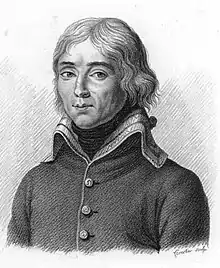Michel de Beaupuy
Armand-Michel Bacharetie de Beaupuy (14 July 1755 – 19 October 1796) was a French soldier. He rose in rank to command an infantry division during the Wars of the French Revolution. He was killed at the Battle of Emmendingen. His surname is one of the names inscribed under the Arc de Triomphe, on Column 18.
Michel de Beaupuy | |
|---|---|
 | |
| Born | 14 July 1755 Mussidan |
| Died | 19 October 1796 (aged 41) Emmendingen (Volgelsheim) |
| Allegiance | Kingdom of France French Republic |
| Years of service | 1776–1796 |
| Rank | General of Division |
| Battles/wars |
|
Life
Republican of noble blood
Michel Beaupuy was born in 1755 in a noble family of the Périgord. At age 16 he enlisted as a simple soldier in the King's army, and two years later he became second lieutenant in the regiment of Bassigny.
Republican soldier
In 1792, as a commander of a battalion of volunteers from Dordogne, he was noticed and named brigade General in 1793. He participated in the siege of Mainz, then was sent to Vendée with the army of Mainz. He was victorious at the battle of La Tremblaye.
He participated in the Virée de Galerne during the War in the Vendée and was wounded a first time at Château-Gontier and a second time during the Siege of Angers.
In 1794 he was transferred to the army of the Rhine to fight in Germany, and was noticed at Gorick and Forsheim. He commanded the rear guard during the retreat of General Moreau through the Black Forest from Freiburg im Breisgau. It is there that he was killed by a cannonball during the Battle of Emmendingen, in Val d'Enfer.
Honors

Monument at Volgelsheim
Construction in 1801 of a monument in Volgelsheim. At the end of the 1850s, the monument was unfinished and covered in vegetation. Colonel Ferru had it restored and finished after his arrival in the area at the head of the 63rd infantry regiment in 1861. The expenses were at the army men's charge and the towns of Neuf-Brisach and Mussidan. The monument was destroyed in 1940 by the Germans, and in 1979 was inaugurated today's actual monument.
- Name engraved on the Arc de Triomphe
- Name engraved at Versailles
Sources
- Jacques de Feytaud, Études sur le sang royal. Les De Brégeas, monographie imprimée, BnF[5], p. 95-96.
- Paul Huot, des Vosges au Rhin, excursions et causeries alsaciennes, Veuve Berger-Levrault & Fils, Paris, 1868, p. 284 à 287.